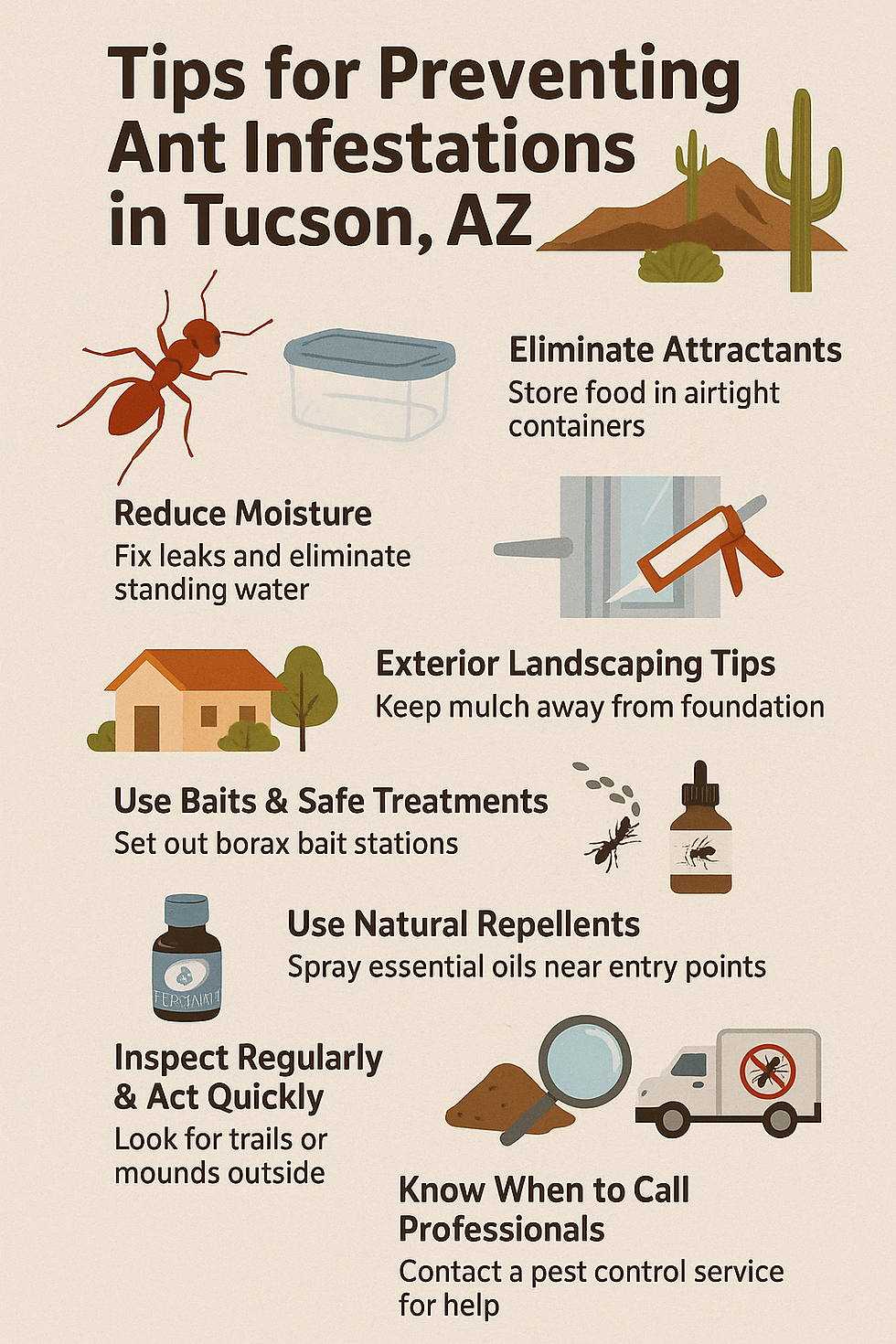🐜 Understanding Ants
- Eric Rodriguez

- Jul 29
- 3 min read
Tucson hosts a variety of ant species, including Argentine ants, odorous house ants, carpenter ants, pavement ants, harvester ants, pharaoh ants, and even fire ants (e.g. southern and desert fire ants) Some species pose little threat beyond annoyance, but carpenter ants can damage wood structures, and fire ants can deliver painful stings

Why Preventing Infestations Is Critical
Food contamination & disease spread: Ants carry bacteria and leave trails in food-prep areas.
Property damage: Carpenter ants bore into decaying wood, compromising structural integrity
Electronics disruption: Ants may nest in outlets or devices, causing malfunctions
Safety hazards: Fire ant stings can be painful or dangerous, especially to children or pets
Prevention Tips for Tucson Homeowners
1. Eliminate Attractants
Store all food (including pet food) in airtight containers.
Clean surfaces promptly: countertops, floors, sinks, pet bowls, trash bins
Inside trash cans, use tight-fitting lids and clean spills immediately
In your garden, avoid compost piles or fallen fruit and clean up aphid-infested plants (ants farm aphids for honeydew)
2. Reduce Moisture
Fix any leaks in faucets, pipes, and irrigation systems.
Ensure gutters are clear and downspouts direct water away from the foundation.
Avoid areas of pooled water, both inside and outside the house
3. Seal All Entry Points
Use caulk or weather-stripping to close gaps around doors, windows, pipes, utility lines, vents, and cracks in foundation or siding.
Trim branches and vegetation so no foliage touches your home exterior, preventing ants from bridging into the house
4. Exterior Landscaping Tips
Keep mulch and organic debris several feet away from your home's foundation.
Use inorganic ground cover near the house to minimize nesting spots.
Remove firewood piles or tree stumps near your home or garden
5. Use Baits & Safe Treatments
Boric acid or borax baits mixed with sugar or syrup are effective for ants to carry back to the colony
Diatomaceous earth (food grade) lightly dusted around entry points or trails works by dehydrating the ants—safe when used properly
Non-repellent residual sprays or perimeter treatments can establish invisible barriers around your home
6. Use Natural Repellents
Essential oils such as peppermint, tea tree, clove, eucalyptus, or lemon oil disrupt pheromone trails and deter invasions
Black pepper, cinnamon, or coffee grounds may also discourage ants at entry points, but they don’t kill them
Vinegar interferes with trail scent but doesn’t kill ants long term
7. Inspect Regularly & Act Quickly
Check for ant trails, dirt mounds, or signs of nesting around the yard or home. Early action can prevent escalation.
Particularly in fire ant season (spring through late summer), scout for new colonies near patios, soil, wood piles, or sidewalks
Persistent or large ant infestations, carpenter ant damage, or stinging fire ants typically require professional intervention.
Local Tucson services like Green Home Pest Control, NW Exterminating, University Termite, or Desert Shield offer focused treatment and maintenance plans, scalable from small homes to larger yards
Expect professional treatments to run between $100 and $500 depending on severity and services
Summary Table
Strategy | What to Do |
Remove Attractants | Store food sealed, clean spills, manage compost/aphids |
Reduce Moisture | Fix leaks, maintain gutters, eliminate standing water |
Seal Entry Points | Caulk gaps, trim vegetation away from home |
Yard Management | Avoid mulch near foundation, remove wood debris |
Ant Baits & Treatments | Use borax/boric acid bait, diatomaceous earth, perimeter sprays |
Natural Deterrents | Essential-oil sprays or pepper/cinnamon barriers |
Routine Inspection | Monitor trails, mounds, and seasonal activity |
Professional Help | For hard-to-control species, recurring nest colonies |


Comments